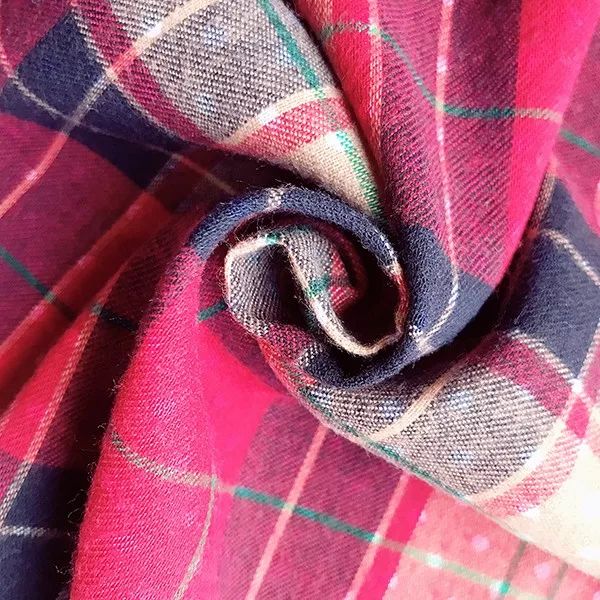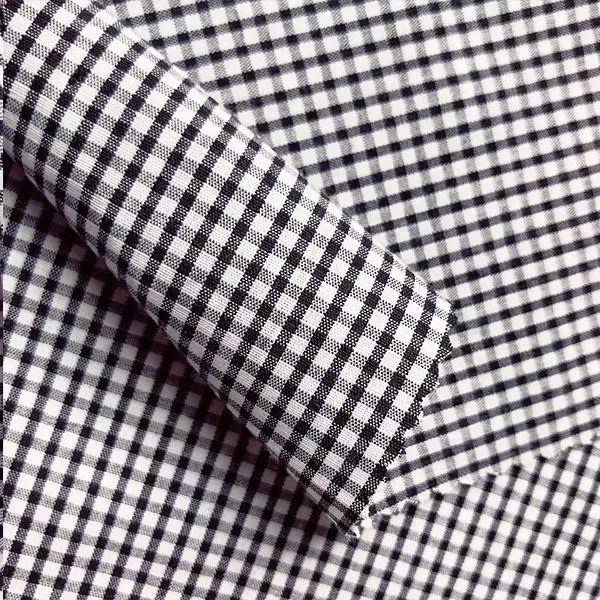Take you to know the functional fabric with full sense of science and technology - flame retardant fiber fabric
Cellulose is a kind of natural macromolecular material endowed by nature. It is not only widely sourced, but also renewable. The process of fiber preparation from cellulose mainly includes viscose method, solvent method (including cuprammonia fiber, ionic liquid, Lyocell fiber), carbamate method, etc. Cellulose fiber has excellent moisture absorption and air permeability, good feel and comfortable wearing. It is often blended and interwoven with wool, cotton or various synthetic fibers, and is used for various clothing and decorative articles. For example, Lyocell fiber, known as the "green fiber of the 21st century", is a newly developed regenerated cellulose fiber in recent years, which has been widely used in various high-end clothing. In addition, all kinds of pure cotton products made of cotton have been in the clothing market for a long time and always occupy a very important position.
However, the limiting oxygen index value of cellulose fabric is low (LOI value is 18.6), which is very easy to burn, becoming a shadow on its development path. According to the investigation, the fire caused by the burning of fiber products has become one of the major disasters in modern society, seriously endangering the safety of human life and property. All countries in the world have issued corresponding fire safety regulations, and increasingly stringent requirements on the application scope and flame retardancy of textiles. In addition, with the improvement of social living standards and the enhancement of flame retardant awareness, people have higher requirements for flame retardancy of fibers and fabrics. Therefore, it is urgent to develop flame retardant cellulose fiber/fabric.
Flame Retardants for Cellulose Fibers and Their Flame Retardant Mechanism

During the thermal cracking of cellulose materials, any bond breaks, producing flammable tar droplets and volatile gases, which are highly combustible substances. Because of the diffusion and heat conduction of volatile gas, the flame spreads to the adjacent surface and heats it to the thermal cracking temperature, thus accelerating combustion. In principle, the flame retardant is added to prevent the ignition of materials and inhibit the spread of flame.
In general, the selection of flame retardants shall meet the following four conditions: ① flame retardancy efficiency of flame retardants to matrix materials; ② Processing technology of flame retardant materials; ③ Compatibility between flame retardant and matrix and its influence on physical properties of matrix; ④ Cost performance tradeoff. Common flame retardants for cellulose fibers are as follows:
Halogen flame retardant
It generally includes chlorine series, bromine series compounds or compounds containing halogen/antimony, etc. Halogen flame retardants play a role mainly through gas-phase flame retardancy, which can inhibit the gas-phase chain reaction, and their decomposition products can be used as inert substances to dilute the concentration and temperature of combustibles, and also have a covering effect (blanket effect). In addition, solid antimony trioxide formed by antimony halide compounds at a certain temperature can promote the carbonization reaction of condensed phase. Halogen flame retardants have many advantages, such as less influence on the physical and mechanical properties of the substrate, high flame retardant efficiency and moderate cost performance. Since decabromodiphenyl ether (DBDPO) was included in the list of persistent organic pollutants in the Stockholm Convention, the application of halogenated flame retardants in fiber flame retardancy has been decreasing.
Flame retardant fabric
Didn't meet you,
The dress also feels that it is not talented.
01
F1703053-1
Phosphorus flame retardant
Including phosphate ester, phosphazene, ammonium polyphosphate, melamine phosphate, etc. Phosphorus flame retardants can improve the charring rate of materials, especially for polymers with high oxygen content. In fact, phosphorus compounds are good accelerants for carbon formation. They generate acid sources through thermal decomposition and undergo esterification or transesterification reaction with the hydroxyl group of cellulose. Through further heating, the phosphorylated cellulose will undergo thermal decomposition, and the combustible volatile products generated from the decomposition of non phosphorylated cellulose will be reduced, and a large number of carbon layers will be formed. Phosphorus compounds have been proved to be effective flame retardants for cellulose fibers. Wei Liu et al. synthesized the phosphorus compound poly (1,2-dicarboxylic acid ethylene spirocyclic diphosphate) (PEPBP). It was found that the smoldering time of the flame retardant cotton fabric treated with PEPBP was shortened, the carbonization length was reduced and the afterburning time was basically zero. Jenny Alongi et al. and A The research of Abou Okeil et al also confirmed that organophosphorus compounds are conducive to improving the flame retardancy and thermal stability of cellulose fabrics.

Renderings of ready to wear models
Nitrogen and silicon flame retardants
It mainly includes urea, dicyandiamide, melamine and silicon dioxide. Nitrogen flame retardants and nitrogen flame retardants are rarely used alone. The synergistic effect between nitrogen flame retardants and phosphorus containing compounds can enhance the flame retardancy of cellulose, improve the charring, and enhance the quality and thickness of carbon layer. SassenachGaana and Patrick Rupper's research confirmed the synergistic effect of flame retardancy between phosphorus and nitrogen. The experimental conclusion indicated that the flame retardancy efficiency of cotton fabrics treated with phosphorus/nitrogen compounds was improved to a certain extent. JoabelRaabea et al. treated cellulose fibers with nano SiO2 by chemical immersion. It was found that the initial degradation temperature of treated fibers was significantly increased. SilvoHibernik and other researchers also found that the silicon carbon layer formed after the combustion of the flame retardant fiber is a thermal insulator, which can effectively prevent the oxygen from penetrating.
Flame retardant fabric
Didn't meet you,
Shirts also feel they are not talented.
02
F1703051-1
Preparation Technology of Flame Retardant Cellulose Fiber
Blending method
The flame retardant is added into the spinning solution, and then solidified by the spinning equipment, so that the fiber has flame retardancy. This method is simple to operate, and the flame retardant fiber produced by this method is superior in hand feeling, water washing resistance and physical and mechanical properties. Professor Cheng Bowen of Tianjin University of Technology and others blended several non-toxic phosphorus flame retardants into the spinning solution and spun flame retardant cellulose fibers by the carbamate method. The results show that the flame retardant fiber has good mechanical properties and flame retardancy.

Renderings of ready to wear models
graft copolymer
Graft copolymerization is used to make the flame retardant react with the main chain of cellulose, so that the flame retardant can exist permanently on the fiber surface. P. R.S. Reddy and others used plasma radiation method to graft phosphorus flame retardant onto cotton fabric, and carried out thermogravimetric analysis, limiting oxygen index (LOI), vertical combustion method and other related tests. The results show that the carbon residue of flame retardant cotton fabric in nitrogen atmosphere is still very high at 900 ℃, and LOI value is significantly increased. In addition, the treated fabric also has good washability. M. J. Tsafack et al. used plasma induced phosphorus flame retardant to graft onto cotton fabric to explore the relationship between the flame retardancy of phosphorus compounds and their structures. Graft copolymerization is a simple process with low production cost.
Flame retardant fabric
Didn't meet you,
Shirts also feel they are not talented.
03

Finishing method
The fabric is immersed in the flame retardant solution, and then the flame retardant is combined with cellulose molecules on the fabric in a physical or chemical way through the processes of pressing, drying and washing, so as to achieve the purpose of flame retardant modification. Post finishing is one of the main flame retardant methods for cellulose fabrics. This method has simple technological process, early application and thorough research. Thach MeinNguyen et al. prepared two different phosphamide ester derivatives (MHP and EHP), and then made the fiber have a certain flame retardancy through post finishing. The LOI is 33.4 when the content of MHP is 20% by oxygen index meter; When the content of EHP is 20%, its LOI is 37.2.
UV curing technology
This technology refers to the process in which the initiators in the system are excited to produce free radicals or cations under the action of ultraviolet radiation, and then initiate the polymerization of materials containing unsaturated double bonds to form a curing structure. UV curing technology, by adding appropriate flame retardants (such as boron, phosphorus, silicon, etc.) to the fabric substrate for UV radiation curing treatment, its surface coating can play a good role in flame retardancy. HaixiaYuan et al. first dipped the cotton fabric in the acetone solution of a certain amount of phosphorus flame retardant PDAH and photoinitiator, used ultrasonic treatment to make PDAH and photoinitiator disperse evenly on the surface of the fabric, and then placed the fabric on the glass plate for UV curing. The results show that when the content of PDAH is 31.21%, the LOI value of the flame retardant fabric is 27, and the carbon residue can reach 36.6% at 600 ℃ in nitrogen atmosphere.
Flame retardant fabric
Didn't meet you,
The dress also feels that it is not talented.
04
F1703054-1
Sol gel method
Using compounds containing highly chemically active components as precursors, these raw materials are uniformly mixed in the liquid phase, and undergo hydrolysis and condensation chemical reactions to form a stable transparent sol system in the solution. After the sol is aged, the colloidal particles slowly polymerize to form a gel with three-dimensional spatial network structure. The gel network is filled with solvent that has lost mobility, forming a gel. The coating can be formed on the fiber surface by sol-gel method, which endows the matrix with various properties, such as flame retardancy, antibacterial property, ultraviolet radiation protection, wrinkle resistance and biomolecule fixation. G. Brancatelli et al. formed P-Si flame retardant film on cotton fabric by sol-gel method. The results show that compared with untreated cotton fabric, P-Si film can effectively improve the carbon residue of flame retardant fabric in the high temperature combustion atmosphere of air and nitrogen.
With the continuous development and innovation of science and technology, it will be the future development trend to treat cellulose with environment-friendly and efficient flame retardants and flame retardant modification methods. On the one hand, it is required that the production of flame retardants should be green and clean, stable and efficient, and avoid or minimize the impact on the performance of cellulose fibers; On the other hand, the preparation of flame retardant cellulose fiber is required to be simple and environmentally friendly, with excellent water washing resistance, flame retardancy and thermal stability. At the same time, with the improvement of people's living standards and the enhancement of environmental awareness, the scientific and reasonable evaluation system of flame retardant fabric materials will be further improved.
Contact: Jeanne yang(MISS)
Phone: 13912652341
E-mail: [email protected]
Add: Room A2216/A2217,Double-Star Building,No 567 New South Middle Road, KunShan City JiangSu Province ,China.